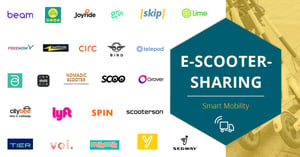Electric scooters appeal to those who want to move quickly and easily through urban streets at low cost while avoiding congestion and solving first-mile / last-mile mobility problems. However, menacing clouds - in the form of safety, regulatory and business model issues - linger above the nascent e-scooter-sharing market, raising questions about its future. A key question is whether cities can find ways for this new micro-mobility service to add value to sustainable urban mobility. In this article, we explore the e-scooter market and competitive dynamics and offer a perspective on smart city challenges.
To learn about the lessons learned from the city perspective regarding the introduction of e-scooter sharing, please read our article E-Scooters: A Collision Between Innovation And Controversy.
The Emergence of a Dynamic Sector
The surprising adoption rate of shared e-scooters suggests this is another disruptive force in transportation - and perhaps another sign of untapped demand for urban mobility innovation. Based on a report from Populus (a San Francisco startup aiming to transform urban transportation), most companies operating in the shared electric scooter market implement similar business models. Each company distributes dockless e-scooters across a city and riders use a smartphone with a mobile app to locate and unlock an available scooter and pay for a ride. The early developers of these services, such as Bird and Lime, relied on eye-popping levels of venture capital funding to aggressively deploy fleets of e-scooters and establish first-mover advantages.
In terms of using smartphone apps and other technologies to deliver on-demand urban mobility, e-scooter companies are similar to ride-hailing operators such as Uber and Lyft. The major difference between an e-scooter sharing company and a ride-hailing company is that "the former owns all the vehicles it deploys (and hence has to shell out cash for each scooter it adds to its fleet)," whereas a ride-hailing operator does not require this upfront investment. The e-scooter ownership model - which also requires companies to cover the costs of battery charging, daily redistribution of the fleet, and vehicle maintenance and repairs - has a significant impact on profit-generating capabilities.
Although Bird, Lime and others entered the market first, the ride-hailing giants are not conceding a potentially attractive market. In late 2018, the ride-hailing provider Lyft entered the shared e-scooter market, and its competitor Uber is also introducing electric scooters and bike-share services as it moves toward "a more comprehensive business model which CEO Dara Khosrowshahi defines as an urban mobility platform,” ideally suited to short distance urban journeys.
A Rapidly Changing Market
The e-scooter sharing market and the competitive situation are characterized by:
- High levels of private financing
- Aggressive moves by initial entrants to establish first-mover advantages and reach critical mass
- Rapid adoption rate (mainly early-adopter youth segment)
- Market expansion to new cities (in spite of a public backlash in numerous locations)
- Regulatory and licensing issues which vary by city
- Attempts by the e-scooter companies to create a competitive edge by improving scooter durability, safety and the rider experience
"Globally, investors put $3.7 billion into electric scooter and electric bike companies in 2018" (through October). "That's up from $2.8 billion for all of 2017, $343 million in 2016, and $13 million in 2015, according to research firm CB Insights."

“The recent trends in e-scooter innovation and adoption should be a sign to smart city leaders that this is another disruptive force that offers the potential to transform urban mobility”, states Thomas Müller, Managing Partner at bee smart city.
High Adoption Rate
Within 12 months after the initial launch of shared e-scooters in U.S. cities, "a remarkably large number of people" reported having used them. The figure below reveals how e-scooter adoption compares to other innovations in urban mobility.
If this trend continues, then e-scooters will approach the high adoption rates achieved by Uber in the ride-hailing sector - demonstrating how urban transport users are eager to try innovative and affordable mobility services.
Drivers of Shared E-Scooter Demand
Key forces leading to e-scooter adoption include the proliferation of GPS-enabled smartphones, severe traffic congestion, attractiveness to low-income groups, and the availability of private financing (enabling e-scooter companies to acquire and deploy large fleets). Shared e-scooters are popular because "they make it easier to get around places where congestion renders driving a horror show and public transit service is falling behind." For those who depend on public transport, dockless scooters offer potential value as an affordable way to solve the first-mile / last-mile problem. At an estimated $2 to $3 per ride, e-scooters offer an attractive option to a taxi or ride-hail trip to the transit stop.

“If smart cities can collaborate with shared e-scooter operators and integrate micro-mobility services with public transport, this could be an important step toward mitigating first mile / last mile problems”, Bart Gorynski, Managing Partner at bee smart city concludes.
Competitive Intensity
In today's urban transport market, the main categories of shared e-scooter mobility operators are e-scooter sharing operators, bike-sharing companies (who have expanded their offering to include shared e-scooters), on-demand ride-hailing companies (who also offer shared e-scooters), and OEMs.
Examples of competitors in the shared e-scooter market are:
- Lime: The current market leader, with funding of $877 million. In cooperation with Uber, providing the advantage of offering e-scooters via the Uber app. Currently operating in U.S. and international cities.
- Bird: The second largest e-scooter operator (behind Lime) with funding of $415 million. In September 2017, Bird was the first e-scooter company to launch services. In the initial year of operation, they attracted 10 million rides in more than 100 cities from over 2 million different riders.
- CIRC (formerly Flash): A recent new entrant; aggressively targeting the European market.
- Lyft: Ride-hailing operator announced its introduction of e-scooters in selected U.S. cities in 2018.
- Scoot: Initial focus on U.S. cities but also testing the market in Barcelona.
- Skip: Another major player with funding of $131 million.
- Spin: An e-scooter operator acquired by Ford in 2018; recently announced a partnership with Zagster to improve fleet operations, safety and ridership loyalty.
- Taxify: Estonian ride-hailing company with plans to compete in multiple locations in Europe and Australia.
- Tier: Based in Germany with financing of $30 million (relatively high, considering that e-scooter sharing in Germany is waiting for legal approval).
- Uber: Rideshare service leader entered the e-scooter-sharing market by partnering with Lime, using the Jump brand, and funding multiple companies.
- Voi Technology: An established e-scooter company with financing of $52 million. Currently operating in cities in six European countries.
- Other e-scooter competitors include Beam, City Bee, Dott, Grin, Grover, Yellow and WIND.
At the moment, Lime and Bird are leaders in the global e-scooter-sharing market. Until recently, Bird was the market share leader before Lime made aggressive moves to increase its market presence and customer base. As a result, Lime's market share grew from an estimated 42% to 53% from late 2018 to early 2019, whereas Bird's share decreased from 66% to 45%, based on research from Second Measure.
In the early stages of their competition, these two companies followed similar strategies: rapid expansion in more cities, accepting losses, raising additional funding, and continuing to expand. Now their strategies are diverging. Bird is changing its focus to profitability, whereas Lime continues to focus on increasing its market share.
Other players in the value chain include those that develop smartphone apps and other software for e-scooter-sharing operators. The smartphone apps (which typically require up to 1,000 hours of development time) consist of a map for the customer to view available scooters nearby, a QR code (to unlock, ride and lock the e-scooter at the end of the ride), payment service integration, and GPS real-time tracking capability. App developers in the e-scooter market include SpaceTechnologies, AllRideApps and MOQO.
Vehicle design and manufacturing have key roles in the e-scooter value chain. Initially, many e-scooter sharing operators acquired e-scooters from Ninebot, a Chinese scooter company. This reliance on a single supplier makes it difficult for any e-scooter company to compete based on a superior vehicle. A few operators are considering other options, such as producing their scooters or working with new suppliers. Inmotion Technologies, a smaller manufacturer in China, claims their e-scooter production "has grown five-fold over the last year" […] and they are "more willing to tailor scooters to customer demands."
From Permissionless to Responsible Innovation
When e-scooter companies first launched their services, they shrewdly implemented a form of permissionless innovation and did not receive a warm welcome from most cities. Adam Thierer, author and senior research fellow at George Mason University, writes that permissionless innovation "refers to the general freedom to experiment and learn through ongoing trial-and-error experimentation." This is a form of innovation that is usually disruptive, upsets societal norms and challenges the regulatory status quo. However, Thierer claims "more often than not, humans adapt to new technologies and find creative ways to assimilate even the most disruptive innovations into their lives."
According to AprilJo Murphy, staff writer at The American Genius, the introduction and rapid growth of e-scooter use in U.S. cities were sudden and unexpected for local government officials and for citizens who were not pleased when e-scooters appeared in front of their homes and businesses. The e-scooter-sharing companies did not apply for permits or negotiate with cities, and residents were given no opportunity to approve the use of their property as e-scooter pick-up stations (or as parking places at the end of a rider's journey).
In Santa Monica, California, city officials "took a hard line" against Bird for its failure to obtain a business license. The company eventually paid $300,000 in fines. In Barcelona, Spain, e-scooter rentals were banned. After e-scooter operator Wind launched services in the city, Barcelona police removed the vehicles from the streets within hours. "This scenario was repeated in Valencia," when Lime deployed a fleet of scooters without authorization from city hall. "Lime's scooters were removed, and the firm was slapped with a fine." Controversy in Spanish cities intensified when safety concerns escalated after complaints about reckless riders and a fatality involving an e-scooter. In addition, e-scooter riders - at the end of their journeys - are blamed for creating safety hazards when leaving the vehicles where they please, blocking sidewalks and other urban spaces.
Safety issues, therefore, represent another layer of controversy for urban mobility planners and policymakers. Only 4.4% of scooter riders in California who suffered injuries in an accident wore helmets. About 32% of injuries involved head trauma. The most common e-scooter accidents were from falls (80%), collision with another object (11%) and getting hit by a moving vehicle or object (9%), based on research from UCLA.
Murphy writes that if the e-scooter sharing companies "desire to be the next major innovation in urban infrastructure, then they need to be prepared to work with and grow alongside the communities they inhabit. It would be a wise move, then, to partner with local governments."
Perhaps the era of permissionless e-scooter innovation must yield more responsible, collaborative innovation with smart cities and the co-creation of urban mobility solutions.
A Questionable Future
Not all transport industry experts are optimistic about the future of e-scooter sharing. Some predict that e-scooter operators will never be profitable at their current low prices. "Now there’s a stalemate where no single company can raise their initial price without causing a mass exodus of users to its competitors." One scenario is that "mergers and acquisitions could change the face of e-scooter sharing. As smaller e-scooter companies run out of money, they could be gobbled up for attractive prices by the larger companies."
"For all the attention and money that Bird, Lime and Spin have raised, they are not going to win the scooter wars. The Uber of scooters is going to be Uber," said Suni Paul (founder of Sidecar) in a Recode article. "It is a replay of tech oligopolies extending their power to squash innovative startups." Vivek Ladsariya (partner at venture capital firm SineWave Ventures), stated in Investor's Business Daily that unless problems involving the public backlash and safety issues are solved, "there's not going to be mass adoption across cities, (and) they won't become mainstream across the world."
Despite these uncertainties, new entrants - such as Berlin startup CIRC (formerly Flash) - continue charging into the e-scooter market. CIRC (formerly Flash) recently announced it secured $55 million in funding. Its co-founder Lukasz Gadowski, following his success as the founder of Delivery Hero, revealed his intention to position CIRC (formerly Flash) as a 'micro-mobility company' that wants to solve the last-mile transportation problem," as reported in an article by Steve O'Hear in Tech Crunch.
Smart City Challenges
The rapid growth in e-scooter usage is another indication that urban mobility services are not meeting the needs of all segments of society. Cities struggling with e-scooter regulatory, licensing and safety issues should consider e-scooter sharing as another innovation - albeit permissionless in some cases - to meet the transport needs of many urban citizens, especially those who seek a low-cost first mile / last mile solution.
Smart cities should also recognize shared e-scooters as an innovation serving only a subset of the urban mobility market. The dockless shared e-scooter is an innovation that is "impractical for many people: Parents who need to drop off kids at daycare before work. People who need to pick up groceries or dry cleaning on the way home. Women wearing heels or a dress. Older workers with impaired balance and stability."

“Although the sudden deployment of shared e-scooters generated controversy in many cities, this innovative e-mobility service may ultimately help cities to deliver sustainable urban transport with lower emissions.”, states Dr. Alexander Gelsin, Managing Partner at bee smart city.
A challenge for smart cities is how to develop policies, regulations, infrastructure and urban space that enable mobility innovation and sustainable transport solutions - which include e-scooters and other (more inclusive) micro-mobility services.
Explore more Mobility Solutions
Access e-scooters and other smart mobility solutions in the global smart city network and community! Join today to explore hundreds of solutions and to connect with thousands of members from across the globe.


